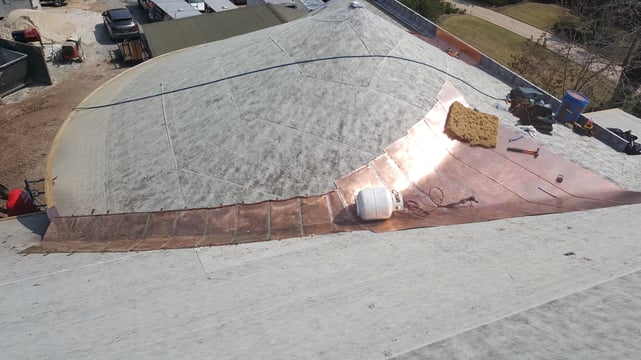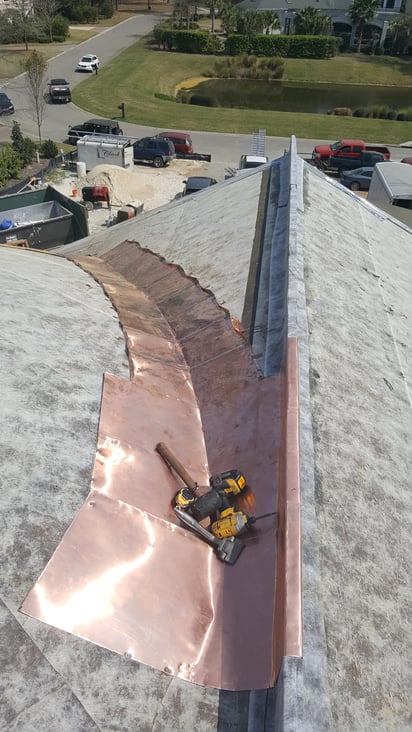Roof Flashing: What Is It & Why Is It Important?
June , 2023 | 5 min. read

When it comes time for the annual block party barbecue, your luxurious shingles or chic metal roof are often receiving all of the credit from your neighbors. I mean sure, it looks fantastic, it’s durable, and it protects you and your family, but the part that makes your neighborhood “ooh” and “aah” is only a mere component of an entire system. What about the unsung hero that nobody praises?
That’s right, I'm talking about flashing. Much like myself being compared to my older sister, I too, get little to no praise. Okay, so maybe I have a soft spot for roof flashing then, but it truly is one of the most important parts of your roof. Without it, your roof is prone to leaks and all of the cascading effects that followAt RoofCrafters, we’ve been repairing and installing flashing since the George Foreman Grill made its debut in ‘94, making thousands of block party barbecues possible might I add, and for the past 30 years, we’ve seen firsthand what a damaged or missing flashing can do to a home. We can assure you it's not pretty.
All of this being said, roof flashing is majorly important. If you’re a homeowner who’s eager to learn just why, you’re in the right place. In this article, you’ll learn what roof flashing is, why it’s important, the different types of flashing available to you, and if having it installed on your home is worth it. Let’s get started!
What Is Roof Flashing and Why Is It Important?
Contrary to popular belief, roof flashing is not when your roof takes its top off. The flashing is a thin and flat metal sheet that is used to prevent water from entering the most vulnerable parts of your roof, such as openings and cracks. It gets placed underneath whatever type of roofing material you have installed, and its purpose is to redirect water to a different location.

Unless you’re a fan of roof leaks and flash floods in your living room, it’s advisable to get flashing installed. Without it, heavy storms can lead to water entering underneath your roofing material and penetrating the underlayment. Soon enough, you’ll be doing some sofa surfing with all of the standing water in your home.
Roof Flashing Importance
Roof flashing is important for many reasons, mainly for protecting the most vulnerable points of your roof. In fact, it's critical to have in the places where your roof’s surface meets a wall, the low points or valleys where two slopes meet, and any roof protrusions such as skylights and vents. Just imagine how detrimental it would be to have wind and rain blowing straight onto these points.
Thanks to the help of flashings, any water gets stopped at the base before it even has the chance to get in between a wall, enter a valley, or compromise your skylights and vents. Do you know how your gutters redirect water away from your foundation to keep your home safe? Your flashing is no different. Think of it as a little gutter for your roof and attic.
What Are the Different Materials and Types of Flashing?
There are many different types of flashing that you can choose from, and they come in 3 different types of metal.
The metal options available to you are:
- Copper
- Steel
- Aluminum
Copper flashing: This material is malleable and highly durable. It tends to have a longer-lasting lifespan, however, it is prone to discoloration over time. Copper flashing is a popular choice around chimneys.
Steel flashing: The most popular choice for flashing is steel flashing. In addition to its aesthetics, like copper it is also malleable and, when galvanized, is corrosion-resistant.
Aluminum flashing: Aluminum is easy for roofers to form and is light in weight making it a popular choice. It’s important that if you choose this material of flashing that it is coated. Aluminum deteriorates when it makes contact with soluble surfaces, so be wary.
Understanding the different types of metal flashings you can choose from is the easy part. Let’s get into the nitty-gritty; the types of flashing. There are many different types of flashing to choose from, but most commonly, homeowners choose between these 8:
- Kickout Flashing: This type of flashing is used to direct water away from the wall and down directly into the gutter.
- Step Flashing: This piece of flashing is bent in the middle and is most commonly used for wall flashing. With step flashing, many different pieces will be installed as layers with the roofing material to make sure the water flows evenly away from the wall.
- Skylight Flashing: Designed to provide the weatherproofing junction between the roof window or skylight, this flashing is manufactured in sections that protect your roof and skylight from taking in water.
- Valley Flashing: A valley flashing will reliably channel run-off water down the roof and into the gutter, protecting the critical area where the two slopes meet.
- Drip Edge: This flashing is installed at the edges of your roof in order to keep water away from your fascia and from working its way underneath your roofing system.
- Continuous Flashing: This type of flashing is a long, single piece of metal that is used to carry water down to the roofing material below it.
- Base Flashing: This flashing is used at the joint between the roofing surface and a vertical surface like a wall, and it guards against water penetration to the roof deck.
- Counter Flashing: This is placed opposite of the base flashing, and is used to cover and protect the upper edge of a base flashing and its associated fasteners.
Is Flashing Worth Its Weight in Metal?
Flashing is an important component of any roofing system and is most certainly worth its weight in metal. Choosing to not install flashing on your roof as a means to save a quick buck not only possibly violates certain codes but puts your home at risk for severe damage early on. Not to mention, if a professional roofing contractor fails to install flashing, they’re most likely performing shoddy work on your entire roof.
As previously mentioned, your flashing protects the most vulnerable parts of your roof, and without it, you can be certain to be a victim of roof leaks and storm damage down the road. If you believe your flashing is damaged, or if you’re interested in learning more, drop us a line on our contact page. One of our friendly representatives will reach out to you and get you scheduled for an inspection at your earliest convenience.
In the meantime, be sure to visit our learning center. We have an abundance of free resources readily available at your fingertips. I recommend reading “What You Need to Know About Roofing Ventilation Systems” next so that you can better understand just how important the jobs of the overlooked components of your roofing system are.
My name is Cassie, and I’m the Content Manager here at RoofCrafters. I was born and raised in Chicago, Illinois, and made my way out to Florida post-college graduation. I’m incredibly passionate about writing and creating valuable content that helps others with the collaboration of my marketing team. When I’m not working, I enjoy shopping (a little too much), spending time at the beach, and reading!



